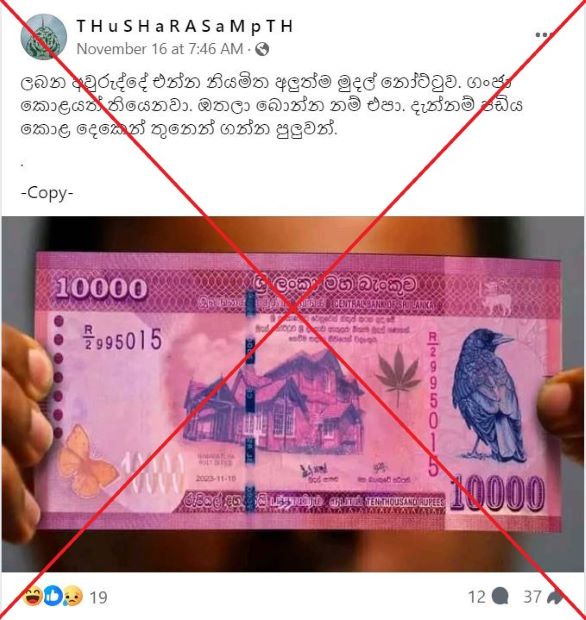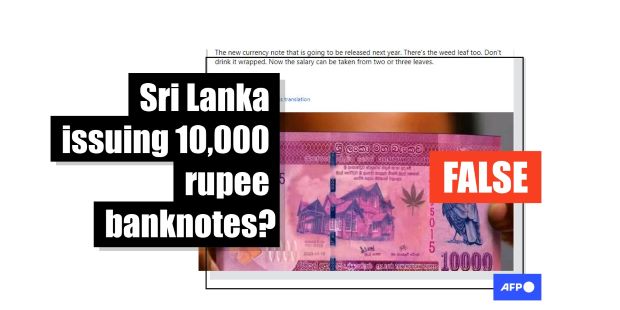COLOMBO – A doctored image showing a 10,000 rupee banknote has been shared on social media alongside claims it is the latest denomination issued by Sri Lanka. But the country’s central bank told AFP no such note has been produced, while an analysis reveals discrepancies with real money.
“The latest to join our list of currency notes – it even has a marijuana leaf. On the plus side, we will now be able to receive our salaries with only a handful of bills,” reads a post in the Sinhala language on Facebook from November 16.
An attached image shows a purported 10,000 rupee (US$30) note featuring illustrations of a crow, a marijuana leaf and a post office in a Sri Lankan hill town.

The claim follows record inflation in Sri Lanka last year of over 60% as the cash-strapped nation battled its worst economic crisis since 1948.
Colombo was forced to seek a $2.9 billion bailout from the International Monetary Fund (IMF) that was finally approved in March this year. The economy has since stabilized, with inflation down to 3.4% in November.
The fake image has been shared elsewhere on Facebook including here.
Comments left by social media users indicated many believed the banknote was genuine.
“What recovery? Ranil is fooling all of us and we are en route to becoming the next Greece,” said one user, referring to Sri Lankan President Ranil Wickremesinghe.
“What a disgrace. We are no different to Zimbabwe now. Well done Wickremesinghe and gang,” another wrote, referencing the African nation’s hyperinflation of recent years.
But the image has been doctored from a genuine photo of a 1,000 rupee note, and Sri Lanka’s central bank confirmed the denomination does not exist.
“This is fake. No such 10,000 rupee note has been issued and there is no plan to issue such a note either,” a spokesperson for the bank told AFP on November 29.
A close analysis of the phoney note said to have been issued in November, reveals multiple inconsistencies with real Sri Lankan cash.
It does not bear the signature of Wickremesinghe, who is also the country’s finance minister.
According to Sri Lanka’s Monetary Law Act, all currency notes should bear the signatures, in facsimile, of the finance minister and the central bank governor.
Below is a comparison between the signature in the fake image (left) and Wickremesinghe’s name as penned by his own hand (right):

The bogus bill also contains three illustrations that carry political undertones not likely to be featured on genuine money.
The marijuana leaf appears to reference ongoing calls to legalise the cultivation of cannabis that could be exported to boost foreign exchange revenue.
A post office in the hill town of Nuwara Eliya is depicted in an apparent reference to the controversy over plans by India’s Taj Group to convert the colonial-era building into a hotel (archived links here and here).
Lastly, an illustration of a crow alludes to former finance minister Basil Rajapaksa, who was nicknamed “kaputa”, the Sinhala word for the bird, by protesters rallying against economic mismanagement last year.
A reverse image search on Russian search engine Yandex found a similar image of a 1,000 rupee banknote published in a Reuters report on March 15 last year. The hands holding the bill appear to match those in the fake image.
Below is the doctored image (left) alongside the Reuters photo (right), with similarities highlighted in yellow by AFP:

All of Sri Lanka’s currency notes in circulation can be viewed on the central bank’s website (archived link).
It says a 10,000 rupee note was last issued back in 1939 and 1940 but was only used for interbank transactions.
The highest-value bill currently in use is 5,000 rupees.
-AFP



Comments are closed, but trackbacks and pingbacks are open.